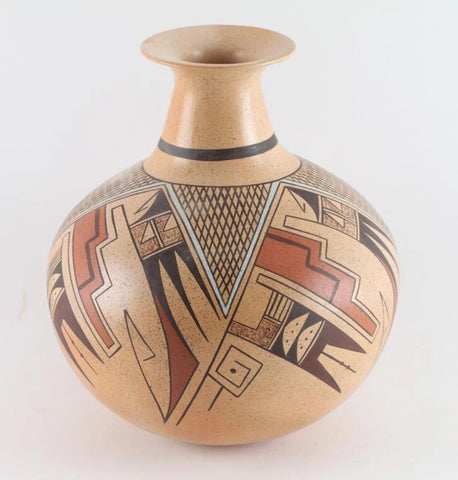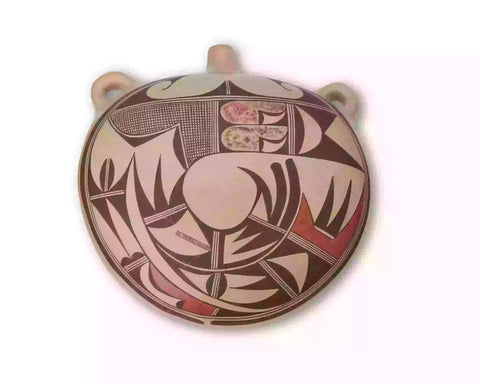
Rare Maricopa Indian Pottery Effigy Vase, by Thelma Bread, CA 1960's, # 1756 SO{LD
$ 2,680.00
Rare Maricopa Indian Pottery Effigy Vase, by Thelma Bread, CA 1960's, # 1756
Description: # 1756, Rare Maricopa Indian Pottery Effigy Vase, by Thelma Bread, CA 1960's. Hand coiled and painted vase depicting seated human figure, signed T. Bread.
Dimensions: 7" x 5.5"
Condition: Superb for its age
Some background on the Maricopa follows:
Sometime prior to the mid 1500's, the people known as the Maricopa today started their long migration from the lower Colorado River and ended up at their present location at the confluence of the Gila and Salt Rivers around 1850.
The Maricopa are Yuman descendants, however due to intertribal warfare and hostilities between the Maricopa and the Yuman and Mohave's the Maricopa moved and settled among the Pima. The last battle was in 1857, near the Gila River, the Maricopa and Piman defeated the Mohave and Yuman, this was the last fight between the groups.
In the 1930s Fred Harvey Labels had helped lead to the confusion of who the Maricopa actually are. In fact, Mabel Sunn during a conversation with Mary Fernald, stated: "Nobody knows about Maricopa. Maricopa are always lumped together with the Pima, and they call Maricopa pottery Pima pottery. But Pima don't make pottery now."
Even though the Maricopa are linguistically related to the Yuman, they are now culturally closer to the Pima. At the time of the Maricopa settlement into the area the Uto-Aztecan speaking Pima and the Spaniards were already residing in the area. The tribes learned to communicate in Spanish. "Maricopa" is from the Spanish word mariposa, meaning butterfly. It is believed the Maricopa were given that name due to their painted faces which resembled butterflies. Bands of "Maricopa" had migrated had different times. Do to the areas that they settled in, the bands currently reside on two different reservations. The people that were mostly Xalychidom Piipaash are now in the area known as Lehi on the Salt River Pima-Maricopa Indian Community. The Pee Posh live on the Gila River Indian Community.
In 1937 to 1940, Maricopa Pottery experienced a revival due to the encouragement of Elizabeth Hart. Elizabeth Hart was a United States Home Extension Agent that noted that the previous pottery pieces (1912 to 1937) showed a decline in craftsmanship. The vessels were poor quality, lopsided and/or lumpy clay, with unevenly spaced designs. The pieces of this time period were a product of tourism, a demand for a cheap low-quality souvenir. On Elizabeth Hart's urging and by the leadership of one of the top potters of the time: Ida Redbird, Maricopa pottery started receiving publicity and support from local museums.
The improved product, thin walled and symmetrical allowed the potters to increase their earnings. Through this revival the "Maricopa Pottery Cooperative" developed, with Ida Redbird as the president of 17 to 19 other Maricopa potters. At Hart's urging, it was at this time that the potters also started signing their wares for individual recognition and credit. So, any Maricopa pottery piece that has a signature and/or hallmark was made somewhere between 1937 to present. A vessel that has no signature and/or hallmark was either made prior to 1937 OR the potter forgot to sign the piece. Swastikas were a common design used in Maricopa pottery until 1941.
The swastika symbol, for the Maricopa, represents the four sacred directions, coordinates of the universe, the wheel of life, the supreme deity. Due to World War II the symbol lost it's popularity with the tourists so the design was no longer used. When Mary Fernald inquired as to the meaning of other designs used, both Mabel Sunn and Ida Redbird agreed that there is no meaning behind most all of the decorations. However, frogs may have symbolized rain. All the Maricopa potters had their favorite designs and symbols, but all were free to borrow from someone else's designs. Despite the borrowing and combination of styles, many times the artist's hand is still individual enough for identification without signature.
Some vessels have a whitish film on them, this has been linked to salty clay usage. If the slip is flaking off it probably is due to the slip being applied to heavily all at once. The slip adheres better to the clay if applied in layers to the desired thickness. The slip can also flake if it had been rubbed to hard with a stone. Maricopa pottery is Paddle and Anvil made. There is no temper in their decorated pots, however they did add temper to cook ware. Cookware were made from a different clay source, they were longer fired and had sand temper added for durability. (Source: Rarepottery.info)
Description: # 1756, Rare Maricopa Indian Pottery Effigy Vase, by Thelma Bread, CA 1960's. Hand coiled and painted vase depicting seated human figure, signed T. Bread.
Dimensions: 7" x 5.5"
Condition: Superb for its age
Some background on the Maricopa follows:
Sometime prior to the mid 1500's, the people known as the Maricopa today started their long migration from the lower Colorado River and ended up at their present location at the confluence of the Gila and Salt Rivers around 1850.
The Maricopa are Yuman descendants, however due to intertribal warfare and hostilities between the Maricopa and the Yuman and Mohave's the Maricopa moved and settled among the Pima. The last battle was in 1857, near the Gila River, the Maricopa and Piman defeated the Mohave and Yuman, this was the last fight between the groups.
In the 1930s Fred Harvey Labels had helped lead to the confusion of who the Maricopa actually are. In fact, Mabel Sunn during a conversation with Mary Fernald, stated: "Nobody knows about Maricopa. Maricopa are always lumped together with the Pima, and they call Maricopa pottery Pima pottery. But Pima don't make pottery now."
Even though the Maricopa are linguistically related to the Yuman, they are now culturally closer to the Pima. At the time of the Maricopa settlement into the area the Uto-Aztecan speaking Pima and the Spaniards were already residing in the area. The tribes learned to communicate in Spanish. "Maricopa" is from the Spanish word mariposa, meaning butterfly. It is believed the Maricopa were given that name due to their painted faces which resembled butterflies. Bands of "Maricopa" had migrated had different times. Do to the areas that they settled in, the bands currently reside on two different reservations. The people that were mostly Xalychidom Piipaash are now in the area known as Lehi on the Salt River Pima-Maricopa Indian Community. The Pee Posh live on the Gila River Indian Community.
In 1937 to 1940, Maricopa Pottery experienced a revival due to the encouragement of Elizabeth Hart. Elizabeth Hart was a United States Home Extension Agent that noted that the previous pottery pieces (1912 to 1937) showed a decline in craftsmanship. The vessels were poor quality, lopsided and/or lumpy clay, with unevenly spaced designs. The pieces of this time period were a product of tourism, a demand for a cheap low-quality souvenir. On Elizabeth Hart's urging and by the leadership of one of the top potters of the time: Ida Redbird, Maricopa pottery started receiving publicity and support from local museums.
The improved product, thin walled and symmetrical allowed the potters to increase their earnings. Through this revival the "Maricopa Pottery Cooperative" developed, with Ida Redbird as the president of 17 to 19 other Maricopa potters. At Hart's urging, it was at this time that the potters also started signing their wares for individual recognition and credit. So, any Maricopa pottery piece that has a signature and/or hallmark was made somewhere between 1937 to present. A vessel that has no signature and/or hallmark was either made prior to 1937 OR the potter forgot to sign the piece. Swastikas were a common design used in Maricopa pottery until 1941.
The swastika symbol, for the Maricopa, represents the four sacred directions, coordinates of the universe, the wheel of life, the supreme deity. Due to World War II the symbol lost it's popularity with the tourists so the design was no longer used. When Mary Fernald inquired as to the meaning of other designs used, both Mabel Sunn and Ida Redbird agreed that there is no meaning behind most all of the decorations. However, frogs may have symbolized rain. All the Maricopa potters had their favorite designs and symbols, but all were free to borrow from someone else's designs. Despite the borrowing and combination of styles, many times the artist's hand is still individual enough for identification without signature.
Some vessels have a whitish film on them, this has been linked to salty clay usage. If the slip is flaking off it probably is due to the slip being applied to heavily all at once. The slip adheres better to the clay if applied in layers to the desired thickness. The slip can also flake if it had been rubbed to hard with a stone. Maricopa pottery is Paddle and Anvil made. There is no temper in their decorated pots, however they did add temper to cook ware. Cookware were made from a different clay source, they were longer fired and had sand temper added for durability. (Source: Rarepottery.info)
Related Products
Sold out
Sold out








